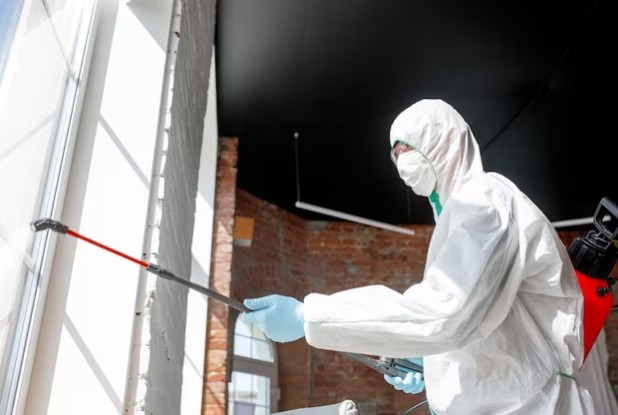If left uncontrolled, mold is a persistent intruder that may ruin both your home and your health.
Mold can be a homeowner’s worst nightmare, whether it’s the characteristic musty smell, unattractive black spots on the walls, or the mysterious allergic problems.
But don’t worry; mold removal is both feasible and necessary for the safety of your house and your family.
We will examine the fundamentals of mold treatment in this extensive manual, including a potent method known as “Dry Ice Blasting” offered by Triangle Radiant Barrier.
Understanding the Mold Menace
Understanding the nature of the issue is vital before getting into the specifics of mold cleanup.
A particular kind of fungus called mold grows best in wet, sticky conditions. It multiplies by dispersing spores into the atmosphere, which land on different surfaces and develop into new colonies.
Mold not only compromises the structural integrity of your house but also puts its occupants’ health at danger.
Common signs of a mold problem include:
1. Visible Mold Growth:
This includes the familiar black, green, or brown spots on walls, ceilings, or other surfaces.
2. Musty Odor:
Mold often emits a distinctive, unpleasant smell that can permeate your living spaces.
3. Allergy Symptoms:
Mold spores in the air can trigger allergies, leading to symptoms such as sneezing, coughing, and skin rashes.
4. Respiratory Issues:
Prolonged exposure to mold can exacerbate respiratory problems, especially in individuals with asthma or compromised immune systems.
Mold Remediation Essentials
To defend your home against mold, you must take a systematic approach to mold remediation. Here are the essential steps to follow:

1. Identify the Source
Before tackling mold remediation, you must locate the source of moisture that is fueling mold growth.
Common culprits include leaks in roofs, pipes, or walls, high humidity levels, and poor ventilation. Fixing these issues is the first step towards effective mold prevention.
2. Wear Proper Protective Gear
Mold can be hazardous to your health, so it’s vital to protect yourself. When handling mold, wear gloves, a mask, and eye protection to prevent exposure to mold spores and mycotoxins.
3. Contain the Affected Area
Isolate the affected area to prevent mold spores from spreading to other parts of your home. Seal off doors and vents with plastic sheeting and use negative air pressure to direct air outside.
4. Remove and Dispose
You can get rid of contaminated items like carpets, insulation, or plasterboard for minor mold issues.
Place these articles in a tight bag and properly dispose of them. s withs, it is best to seek the advice of a professional mold treatment service.
5. Cleaning and Disinfecting
Use a solution of water and detergent to scrub the damaged surfaces. Specifically designed mold-killing products are another option.
Make sure to thoroughly clean the area around the mold as well as the visible mold because mold can lurk in places that are not immediately apparent.
6. Drying and Dehumidification
Thoroughly dry the cleaned area and maintain low humidity levels to discourage future mold growth. Using dehumidifiers can be highly effective in achieving this goal.
7. Inspection and Prevention
After remediation, it’s essential to inspect your home regularly for any signs of mold resurgence. Continue to address moisture issues and ensure proper ventilation to prevent mold from returning.
The Power of Dry Ice Blasting
Now, let’s introduce an advanced mold remediation technique: Dry Ice Blasting. This method has gained popularity for its effectiveness in removing mold without causing damage to surfaces or using harmful chemicals.
Here are some key advantages of Dry Ice Blasting in mold remediation:
– Non-Toxic: Dry Ice Blasting is non-toxic because no chemicals or abrasives are used, making it safe for the environment and the people living in the house.
– Surface-Friendly: Unlike conventional abrasive techniques, Dry Ice Blasting is mild on surfaces, guarding against harm to materials like wood, metal, and even electrical components.
– Effective: Complete mold removal is ensured by Dry Ice Blasting’s ability to access confined spaces.
– – Minimal Cleanup: There is little residue to clean up after the procedure because dry ice pellets sublimate into gas upon impact.
– Rapid drying: By leaving surfaces dry, the technique lowers the chance that mold may continue to grow as a result of moisture.
However, it’s important to note that Dry Ice Blasting may not be suitable for all mold remediation situations. It’s best to consult with a professional mold remediation service to determine the most appropriate method for your specific case.
Conclusion
When it comes to defending your house and the health of its people, mold treatment is not a choice but a requirement.
You may successfully protect your property against the mold threat by adhering to the crucial steps given in this book and taking into account cutting-edge treatments like Dry Ice Blasting when applicable.
Recall that the best defense against mold damage and health issues is early diagnosis and fast intervention.